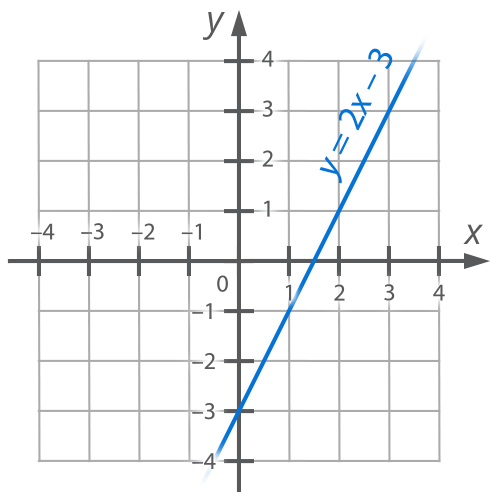In this lesson we will introduce the concept of a linear function, derive it in general form, and consider special cases. We will introduce new terminology, consider typical problems and elementary examples.
Reminder of some theoretical facts and solution of the reference problem.
In the previous lessons we studied a linear equation with two variables, an equation of the form ![]() ,
, ![]() . We found out that the graph of this equation is a line. Let's look at an example:
. We found out that the graph of this equation is a line. Let's look at an example:
Example 1:
![]() (1)
(1)
Let's rewrite it so that Y is in one part and everything else is in the other part:
![]()
Let's reduce by 2:
![]()
Let's move y to the left side and everything else to the right:
![]() (2)
(2)
We obtained a special case of equation 1, in which Y stands alone in the left part; the graph of both expressions will be the same straight line, but we will call the entry 2 a linear function of Y from X.
Let us construct a graph of this function by making a table:
|
х |
0 |
1.5 |
|
y |
-3 |
0 |

Define a linear function in the general case from a linear equation with two variables:
![]()
![]()
Since ![]() we can divide both parts by b:
we can divide both parts by b:
![]()
Let us introduce a more convenient notation:
![]() ,
, ![]()
We get the expression:
![]() (3)
(3)
For example №1 ![]() ,
, ![]()
Thus, a pair of numbers k and m defines a particular linear function.
In a linear function, the variable x is called the independent variable or argument of the function; we can choose an arbitrary value of x and use it to find the corresponding value of y.
Y is called the dependent variable or function.
A linear function is characterized by the fact that if the value of x is given, you can immediately get the value of y. y is a linear function of x.
Let us find the points of intersection with the axes for the linear function in general form (3). All points on the y-axis are characterized by the fact that their abscissa, the x-coordinate, is zero.
![]() ,
, ![]() ;
;
Point of intersection with the y-axis: (0, m)
Hence the geometric meaning of the variable m is the ordinate of the point of intersection of line 3 with the y-axis. The parameter m uniquely defines the point of intersection of line 3 with the ordinate axis.
The parameter ![]() is called the angle coefficient.
is called the angle coefficient.
All points on the x-axis are characterized by the fact that their ordinate is zero. Find the intersection point of our function with the x-axis:
![]() ,
, ![]() ,
, ![]() ,
, ![]()
Point of intersection with the x-axis: (![]() )
)
Example 2:
Plot the graphs of two linear functions: ![]() (4),
(4), ![]() (5)
(5)
In function 4 ![]()
In function 5 ![]()
In order to construct the graphs, we make tables in which we write the points of their intersection with the coordinate axes:
|
х |
0 |
-3 |
|
y |
m=3 |
0 |
Table for function 4;
|
х |
0 |
3 |
|
y |
m=3 |
0 |
Table for function 5;

Fig. 2. Graphs of the functions y=-x+3 and y=x+3
So from the construction we see that when ![]() (line
(line ![]() ) the angle
) the angle ![]() between the line and the positive direction of the x-axis is acute, and when
between the line and the positive direction of the x-axis is acute, and when ![]() (line
(line ![]() ) the angle
) the angle ![]() between the line and the positive direction of the x-axis is obtuse.
between the line and the positive direction of the x-axis is obtuse.
The root of function 4 is -3, because at this value of x the function turns to zero.
The root of function 5 is 3, because at this value of x the function turns to zero.
Note that the solution of the following system:

is the point (0; 3).
Solving typical problems
Example 3 - find k and m:
![]()
We set a linear equation, since x and y are in the first power, with two variables.
To find k and m, perform transformations:
![]()
Let us write the resulting expression in the standard form:
![]()
It is obvious from this that ![]() , and
, and ![]()
Example 4 - find k and m:
![]()
Convert the right part:
![]()
Let us write the resulting expression in the standard form:
![]()
It is obvious from this that ![]() , and
, and ![]()
So, one of the standard problems is to find the parameters of a linear function k and m from a given linear equation.
Two more standard problems are to find y by a given value of x and vice versa, to find x by a given value of y. Consider an example.
Example 5 - Find the value of y at ![]() :
:
![]()
![]()
![]()
Such a problem is sometimes called a direct problem.
Example 6 - find the value of an argument if ![]() :
:
![]()
![]()
![]()
![]()
This problem is called an inverse problem.
Lesson Conclusions
Conclusion: In this lesson we have looked at linear functions both in particular cases and in general, defined the parameters of a linear function and their meaning, introduced some new terms, and learned how to solve elementary typical problems.
2. If you find an error or inaccuracy, please describe it.
3. Positive feedback is welcome.